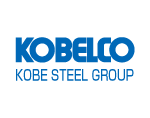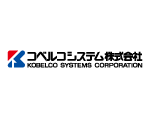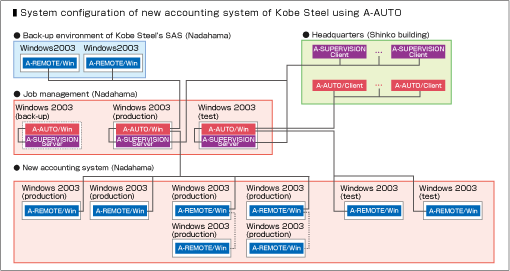Top > Products & Services > Case Studies > Kobe Steel Ltd.
* The company names and the contents of the case studies are given as of the time of the interview.

Kobe Steel, Ltd.

Kobelco Systems
Corporation
Kobe Steel, Ltd. (hereafter "Kobe Steel"), has been a leading iron and steel producer in Japanese and global markets since its foundation in 1905. It holds the largest share in various industrial segments, ranging from iron and steel and welding products (such as steel plates and wire rods) to aluminum and copper, industrial machinery, and construction machines.
One of its group companies, Kobelco Systems Corporation (hereafter "Kobelco Systems), provides a variety of IT services, such as consulting, system integration, and outsourcing in various areas including product design, production planning, and logistics of the products Kobe Steel produces. Kobelco Systems also has strength in IT infrastructure solutions, including data center solution.
Kobe Steel is currently collaborating with Kobelco Systems on the transition of its headquarters' business systems to open systems. In 2006, as a part of the project, it began a major shift of the headquarters accounting system to a new system that uses BSP's job scheduling software, A-AUTO. This shift took only about a year. Regarding the project, BSP has recently interviewed Mr. Nobutaka Koga and Mr. Masahiro Kanto of the IT Planning Department of Kobe Steel and Mr. Masaki Nakanishi and Mr. Seiji Okubo of the Strategic Outsourcing Group of Kobelco Systems headquarters.

Mr. Nobutaka Koga
IT Planning Department
Kobe Steel, Ltd.
Kobe Steel headquarters is working to renovate its IT infrastructure by migrating from its mainframe-based system to open systems by the end of March 2012. In the former system environment, every revision of applicable laws and regulations required a modification, which entailed high costs for maintenance. Another major problem was that the many changes and modifications had made the system so complicated that overall control and management were difficult.
Taking all this into consideration, the company determined to place open systems taking the maximum advantage of application packages as a core of the new system, and set a goal to establish an IT infrastructure that would offer high availability, low operational cost, and the ability to adapt flexibly to future modifications and extensions.
The company launched full-scale discussions for the renovation of the accounting system in 2006, and began planning and designing a new system architecture based on application packages. In April 2007, Kobe Steel set up a test environment and the preparation for the full-scale development phase started.
A-AUTO was selected for the job management of the new accounting system. Said Mr. Koga, "Internally developed operation tools had been used on the mainframe, but as part of our move to the open systems we had already adopted A-AUTO to manage jobs on open systems, such as those on financial and HR systems. Our choice for the new accounting system was also A-AUTO. Because so far we have encountered no problems in operations management, we believe that there is no reason to install any job scheduling software other than A-AUTO."

Mr. Masahiro Kanto
IT Planning Department
Kobe Steel, Ltd.
In the migration project, the highest emphasis was placed on establishing the framework, by preparing thoroughly and selecting the team members carefully. It was very important to ensure that all of those involved in the project would achieve a consensus and a common awareness in the transition process.
"The project was expected to involve 100 to 200 members at the peak period," said Mr. Nakanishi. "We believed that it would succeed only if all members united their efforts. Because we prepared as carefully, and devoted all of the time and effort needed, the system development was completed in about six months." Mr. Nakanishi commented.
The hardest part of the development was to validate the output from the new system. They needed to be compared every day against the output from the current system. All these checks required much time and patience. Having them done by a single staff member could easily have led to mistakes or low performance, and the validation would have taken two or three months. Therefore, the project team developed a procedure by which the workload was shared by multiple staff members, in cooperation with operation staff of the old system.
Reflecting on the difficulties he faced, Mr. Kanto said, "A-AUTO was adopted in the expectation that it would work as an effective tool for job management covering the interface processing between multiple systems. We needed some efforts to control EAI tool. At the beginning of the project, we did not plan to have a test environment for A-AUTO but we ended up to set up one and tested job scheduling carefully before going into the production."
The support services provided by BSP made a large contribution to the success of the project. Mr. Okubo rated BSP's services highly, commenting, "When I sent an e-mail to my BSP contact asking questions on something I did not dunderstand, I received a prompt reply within 20 to 30 minutes. Thanks to the quick, kind, and complete responses to my e-mails, I was able to bring the project forward smoothly without delaying the validation processes.

Mr. Masaki Nakanishi
Section Chief
Headquarters Technical
Development Office
Service Business Division
Strategic Outsourcing Group,
Department I
Kobelco Systems Corporation

Mr. Seiji Okubo
Headquarters Technical
Development Office
Service Business Division
Strategic Outsourcing Group,
Department I
Kobelco Systems Corporation
In April 2008, the project was about to switch over to the production phase. This was the final stage of the project, allowing no mistake. To migrate all the data for the full-year financial closing to the new system, Kobe Steel planned to process its financial data on the old system up to the account-closing transactions for the term ending March 2008, and therefore, keep the old system operating even after the cutover of the new system. That means that two systems would be running in parallel.
The migration process was tackled by a carefully chosen team, in which the operation and development staff of the old system collaborated closely with the project team. As the project was handled mainly by people fully familiar with both systems, operations of the new system after migration went smoothly. This was the key to the success of the migration.
In May 2008, the complete migration to the new accounting system was finished in a short time, without any major problem. It was an excellent accomplishment. Its success was due to the careful and detailed making of plans and selection of team members, and the enthusiastic efforts of all of those involved.
With this project successfully completed, Kobe Steel is now working on a second one, scheduled for completion in April 2010. The next goal is to standardize the format of all data connections among the companies in headquarters. This will lead to the integration of the systems of all of these companies, and ultimately that of the entire Group. The challenges of Kobe Steel and Kobelco Systems are far from over, but past performance makes success seem assured.
|
【Corporate Profile】 Company Name: Kobe Steel, Ltd. Founded: 1905 Description of Business: Iron and steel products, wholesale power supply, aluminum and copper products, machinery, construction machinery, real estate and other businesses. URL : http://www.kobelco.co.jp/english/ |
|---|
|
【Corporate Profile】 Company Name: Kobelco Systems Corporation Founded: 1983 Description of Business: Consulting services, design, development, and maintenance for business systems and networks, outsourcing and other services URL : http://www.kobelcosys.co.jp/ |
|
【Product】 A-AUTO |










